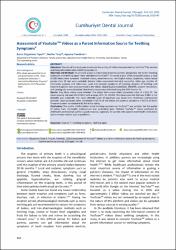| dc.contributor.author | Güçyetmez Topal, Burcu | |
| dc.contributor.author | Tıraş, Melike | |
| dc.contributor.author | Tanrıkulu, Ayşenur | |
| dc.date.accessioned | 2022-05-06T12:11:00Z | |
| dc.date.available | 2022-05-06T12:11:00Z | |
| dc.date.issued | 2022 | en_US |
| dc.identifier.citation | %0 Cumhuriyet Dental Journal ASSESSMENT OF YOUTUBE™ VIDEOS AS A PARENT INFORMATION SOURCE FOR TEETHING SYMPTOMS %A Burcu Güçyetmez Topal , Melike Tıraş , Ayşenur Tanrıkulu %T ASSESSMENT OF YOUTUBE™ VIDEOS AS A PARENT INFORMATION SOURCE FOR TEETHING SYMPTOMS %D 2022 %J Cumhuriyet Dental Journal %P 1302-5805-2146-2852 %V 25 %N Supplement %R doi: 10.7126/cumudj.1032716 %U 10.7126/cumudj.1032716 | en_US |
| dc.identifier.issn | 2146-2852 | |
| dc.identifier.uri | https://doi.org/10.7126/cumudj.1032716 | |
| dc.identifier.uri | https://hdl.handle.net/20.500.12933/912 | |
| dc.description.abstract | Objectives:The aim of the study was to evaluate the quality of information provided by YouTube™ for parents searching information about teething symptoms. Material-Methods:To simulate access to information from the parents’ perspective, the terms "teething symptoms and teething signs" were searched on YouTube™. To obtain a total of 60 acceptable videos, a total of 100 videos were screened. Irrelevant videos, advertisements, non-English videos, duplicates, videos lasted greater than 15 min were excluded. General video assessment included ownership, video age, number of comments, purpose and references. Local and systemic symptoms of teething, duration of teething, and treatment options were also examined in the videos. Global Quality Scale(GQS), DISCERN, viewers’ interaction, and viewing rate were calculated. Statistical analysis was performed using the SPSS Version 26. Results:Sixty three videos were included. The videos had a mean video interaction index of 1.36±3.39. The mean viewing rate was 6915±18125 with a range of 0.7 to 115498. The mean score for GQS was 2.98±1.1, for DISCERN was 1.03±0.89. The mean DISCERN score of layperson was lesser than healthcare professionals (p<0.05). Local symptoms were mentioned in 85.7% of the videos and systemic symptoms in 58.7% of them. Treatments were mentioned in 61.9% of the videos. Conclusions: The quality of information about teething symptoms on YouTube™ was variable, but the quality of videos from laypersons was particularly poor. Reliable YouTube™ videos published by childhealth professionals will be a good resource, especially for parents who cannot reach health institutions due to various reasons such as pandemic. | en_US |
| dc.language.iso | eng | en_US |
| dc.publisher | Sivas Cumhuriyet Üniversitesi | en_US |
| dc.relation.isversionof | 10.7126/cumudj.1032716 | en_US |
| dc.rights | info:eu-repo/semantics/openAccess | en_US |
| dc.subject | YoutubeTM | en_US |
| dc.subject | Teething Symptoms | en_US |
| dc.subject | Teething Signs | en_US |
| dc.title | Assessment of YoutubeTM Videos as a Parent Information Source for Teething Symptoms | en_US |
| dc.type | article | en_US |
| dc.authorid | 0000-0002-9932-9169 | en_US |
| dc.authorid | 0000-0001-7723-1155 | en_US |
| dc.authorid | 0000-0002-9644-8939 | en_US |
| dc.department | AFSÜ, Diş Hekimliği Fakültesi, Klinik Bilimler Bölümü | en_US |
| dc.identifier.volume | 25 | en_US |
| dc.identifier.issue | Suppl | en_US |
| dc.identifier.startpage | 114 | en_US |
| dc.identifier.endpage | 118 | en_US |
| dc.relation.journal | Cumhuriyet Dental Journal | en_US |
| dc.relation.publicationcategory | Makale - Uluslararası Hakemli Dergi - Kurum Öğretim Elemanı | en_US |
















